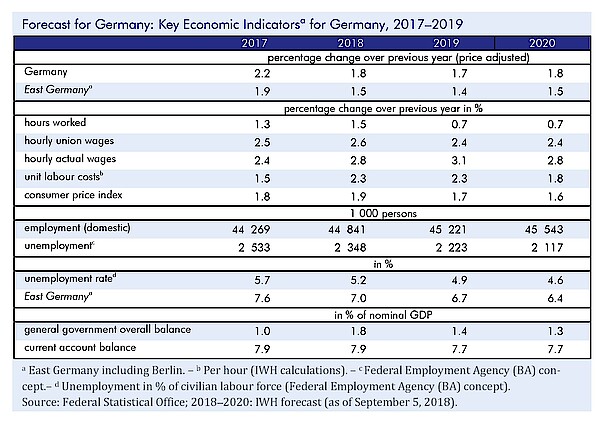The Cyclical upswing in Germany continues, in spite of foreign demand losing momentum
In autumn 2018, the global economy continues to expand quite strongly. Regional differences, however, have increased since the beginning of the year. While the cyclical upswing in the USA, driven by the strong impetus from the tax reform, has gained even more strength, the economy in the Euro area has weakened somewhat, and world trade is roughly stagnant since the beginning of the year. The weakness of trade can partly be explained by the various trade conflicts between the US and major trade partners. The possibility of escalating trade conflicts is just one of several risk factors for the German economy. Others are the possibility of a disorderly exit of Great Britain from the European Union in the spring of 2019, as well as a further loss of confidence on financial markets in the solvency of the Italian state, in case the government of Italy realises its fiscal projects on a large scale.

The German economy has been booming for five years. Important drivers are the exceptionally favourable financing conditions and a strong expansion of employment. However, demand from abroad has recently lost momentum. A slide in competitiveness of German producers due to the appreciation of the euro since spring 2017 plays a role here. The expansionary fiscal policy will give the economy a tail-wind especially in 2019, but high capacity utilisation and labour market bottlenecks are likely to hinder further vigorous expansion. According to this forecast, the growth rate of real gross domestic product will be 1.8% in 2018 and 1.7% in 2019. The East German economy will expand by 1.5% this year and by 1.4% in 2019.
Whom to contact
For Researchers

Vice President Department Head
If you have any further questions please contact me.
+49 345 7753-800 Request per E-MailFor Journalists

Internal and External Communications
If you have any further questions please contact me.
+49 345 7753-832 Request per E-MailIWH list of experts
The IWH list of experts provides an overview of IWH research topics and the researchers and scientists in these areas. The relevant experts for the topics listed there can be reached for questions as usual through the IWH Press Office.
Related Publications

Konjunktur aktuell: Aufschwung in Deutschland setzt sich trotz nachlassender Impulse aus dem Ausland fort
in: Konjunktur aktuell, 3, 2018
Abstract
Im Herbst 2018 ist die Weltkonjunktur weiterhin recht kräftig. Allerdings haben die regionalen Differenzen seit Jahresbeginn zugenommen. Während der Aufschwung in den USA auch wegen des starken Impulses durch die dortige Steuerreform noch einmal an Kraft gewonnen hat, ist die Konjunktur im Euroraum etwas schwächer geworden. Der Welthandel hat seit Jahresbeginn kaum noch zugelegt. Eine Ursache dieser Stagnation ist die Verschlechterung der handelspolitischen Rahmenbedingungen. Die Handelskonflikte sind allerdings nur einer von mehreren Risikofaktoren für die deutsche Konjunktur. Hinzu kommen die Möglichkeit eines ungeordneten Austritts Großbritanniens aus der EU im Frühjahr 2019 sowie ein weiterer Verlust an Vertrauen der Finanzmärkte in die Solvenz des italienischen Staates, falls die Regierung Italiens ihre finanzpolitischen Vorhaben in großem Stil umsetzt. Die deutsche Wirtschaft ist seit fünf Jahren im Aufschwung. Wichtige Treiber sind die außerordentlich günstigen Finanzierungsbedingungen und eine starke Expansion der Beschäftigung. Zuletzt hat die Nachfrage aus dem Ausland allerdings an Schwung verloren. Dabei spielt auch die Verteuerung deutscher Produkte aufgrund der Aufwertung des Euro seit dem Frühjahr 2017 eine Rolle. Die in diesem Jahr und besonders im Jahr 2019 expansiv ausgerichtete Finanzpolitik verschafft der Konjunktur Rückenwind, aber hohe Kapazitätsauslastungen und Engpässe beim Beschäftigungsaufbau dürften eine weitere kräftige Expansion behindern. Das reale Bruttoinlandsprodukt liegt nach vorliegender Prognose im Jahr 2018 um 1,8% höher als im Vorjahr, im Jahr 2019 beträgt die Rate 1,7%. Die ostdeutsche Wirtschaft expandiert in diesem Jahr um 1,5% und im Jahr 2019 um 1,4%.



